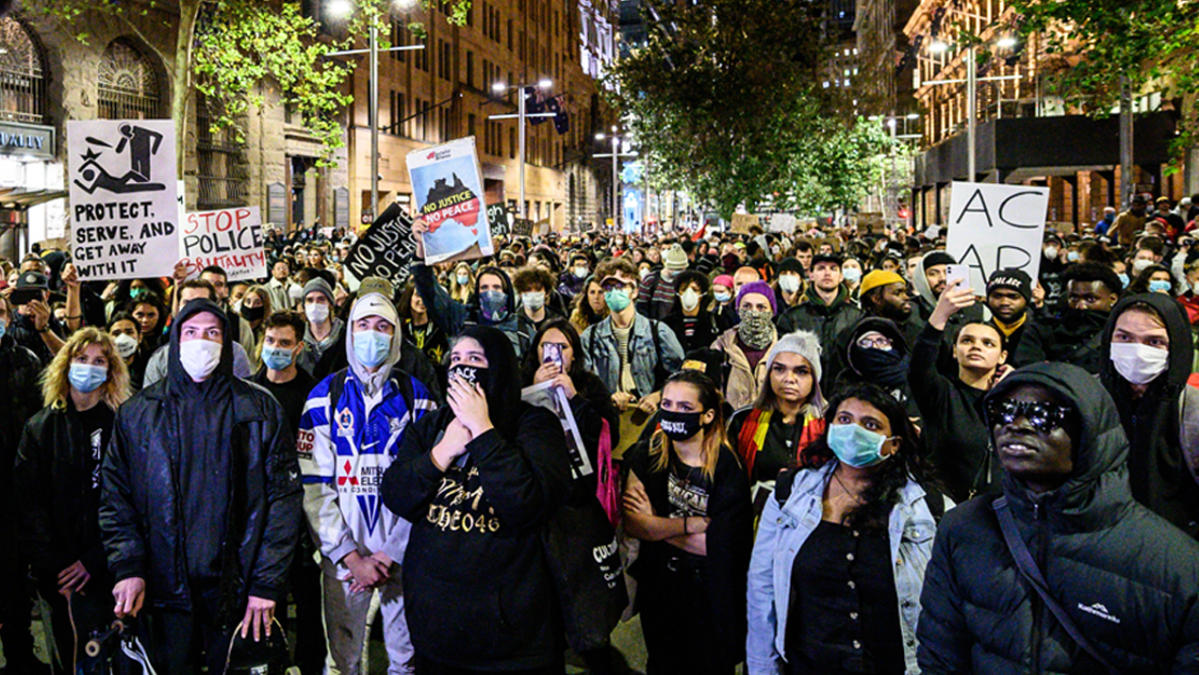
Around Australia, people are filling the streets in solidarity with the US protests and to speak out against Indigenous deaths in custody. These are hugely important issues to speak up about, but in the time of COVID-19, it’s vital you do so safely.
That doesn’t change the fact we’re in a global pandemic, and most parts of Australia are still under relatively strict lockdown restrictions.
PEDESTRIAN.TV spoke to infection prevention researcher Associate Professor Philip Russo, from Monash University, about what precautions to take.
“The most important part is to maintain social distancing,” he said.
While the safest bet will always be to stay at home, if you’re still keen on making your voice heard in the streets, here are a few tips to slightly minimise the risks.
Make sure you’re socially distancing, as always
This applies to every aspect of our lives at the moment, and it’s doubly-true for large gatherings of people.
Unlike previous protests, we now need to keep 1.5 metres apart from one another. That includes when we’re marching, standing and kneeling.
It should go without saying, but no hugs, high-fives, handshakes or any other kind of contact, either.
Many protest organisers are asking attendees to follow social distancing guidelines.
The upcoming Sydney vigil for George Floyd and David Dungay Jr., for example, will have marshalls splitting people into groups of 50. Within those groups, people will be asked not to stand shoulder-to-shoulder.
Scenes from Monday’s Black Lives Matter rally in Perth #BLMPerth pic.twitter.com/h0AAP8VmRi
— Christine (@christineeeexox) June 3, 2020
Wear a mask, but don’t think it’s a coronavirus shield
This is a tricky one, because a mask in and of itself won’t protect anyone.
“Masks unfortunately give people a false sense of security,” Russo told P.TV.
“Standing shoulder to shoulder whilst wearing a mask still puts you at high risk of spreading the coronavirus.”
Russo says it’s much more important to follow social distancing recommendations and wash your hands than just using a mask.
However many organisers are still asking attendees to wear masks.
Although masks won’t act like a coronavirus shield, they will prevent people from coughing on one another.
So when used in conjunction with social distancing and hand-washing, they’re still somewhat useful.
Be strategic about your transport options
If you can drive, do so.
Of course, not everyone has a car (or a licence!) and it’s not always easy to find parking at some of the protest locations.
The new public transport guidelines are there for a reason. If you do have to catch a bus or train, make sure you follow the signs and sit on the indicated seats, away from other passengers.
Try not to touch anything, either.
the protest tonight in sydney against aboriginal deaths in custody and in solidarity with #BlackLivesMatter #AboriginalLivesMatter pic.twitter.com/vlPetVaTg0
— Adrian S. (@cckatoo) June 2, 2020
Wash your hands
Do it. Bring sanitiser, too!
Be loud without spreading droplets
We spread respiratory droplets whenever we cough or speak. When we chant and shout, these droplets spread even further.
If you’re not wearing a mask, chanting in a protest can therefore risk spreading germs.
Some alternatives that’ve already been used at rallies include horns, drums, clapping and stamping feet. All of these make heaps of noise, and all are super powerful.
For people giving speeches, a megaphone is a good way to raise your voice without spraying droplets all over the crowd.
If worse comes to worse, try to cover your mouth and shout away from others’ faces.
Harm reduction for protests in a pandemic:
•wear your mask + eye protection + heat resistant gloves
•yelling can spread droplets, choose signs, drums, or similar noise makers
•stick with a buddy group to keep your unknown contacts low
•carry water + hand sanitizer + bandages— Dr Ellie Murray, ScD (@EpiEllie) May 30, 2020
Consider online protests
Some protests will have livestreams which may be a better way to participate.
Remember, there will likely be Indigenous elders at many of these rallies and vigils, who may be more-at-risk than yourself.
Follow the event’s Facebook page closely, and consider whether you need to attend in person or online.
“By attending the protest you may well be putting those communities that you are trying to protect at greater risk,” Russo said.
“So if there is another form of protest, please consider.”
On top of that, if you live with at-risk or immunocompromised people, there’s always a chance you could bring the virus back home.
If you’re going to a protest this week in Australia. Please dont go if you are unwell. Indigenous Australians have high levels of immunocompromised conditions. If you do go, take hand sanitiser, wear a mask and keep your distance.
— Aimee (@AimeeintheWoods) June 3, 2020
Stay TF home if you’re sick
If you have a cough, runny nose or fever, you absolutely should not be leaving the house at this time.
Attending a protest is even worse, because you risk spreading your symptoms to hundreds of others.
Rest up, call your GP, and get tested if you need to. Nobody will accuse you of not caring if you’re too sick to protest.







